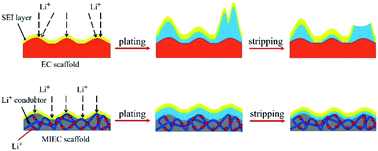CuO–C modified glass fiber films with a mixed ion and electron-conducting scaffold for highly stable lithium metal anodes†
Abstract
The most critical issue hindering the practical application of lithium metal anodes in secondary batteries is the uncontrollable growth of dendrites, which is caused by the uneven supply of lithium ions transported from the inevitably inhomogeneous solid electrolyte interface (SEI) layer on the electrode surface. During lithium deposition, the intrinsically uneven distribution of lithium ions on the anode surface causes the lithium to be liable to deposit at tips and humps, and this results in uncontrollable dendrite growth. Herein, CuO–C modified glass fiber films with a mixed ion and electron-conducting network are proposed to realize homogenized lithium ion flux via providing widespread inner lithium ion transport channels in the skeleton. The improved lithium ion transport in the anodes can remarkably weaken the polarization of lithium plating, further contributing to uniform lithium deposition and high cycling stability. Owing to the high-performance mixed ion and electron transport frameworks, the resultant half cells achieve a long lifespan of over 500 cycles at 1 mA cm−2. Moreover, a full battery coupled with LiFePO4 shows enhanced rate capabilities and high cycle stability, with retention of 81.1% at 1C over 400 cycles compared with a Cu–C modified glass fiber film scaffold.



 Please wait while we load your content...
Please wait while we load your content...